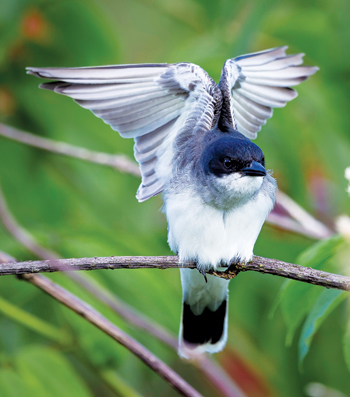Rare Bird Spotted In Indiana – Life In The Outdoors

We were cruisin’, my older daughter and I, my daughter driving, on back roads, country roads, watching the fields we passed, noting how the scenery has changed in just the few weeks. Many of the leaves on the trees have changed from green to yellow and red and brown. Many leaves have fallen. There seem to be nearly as many tree leaves on the ground as on the trees. Goldenrod is in bloom. Sumac leaves are turning red.
We were watching for birds too, of course. I’m always watching for birds. But we didn’t see many, one kestrel, a small flock of starlings, two crows, two turkey vultures. Then my daughter spotted a different bird, a rare bird, to us. It was a little black and white bird.
My daughter’s rare bird was black from the top of its head to below its eyes. Its bill, too, was black, and its legs and feet. Its back, wings and tail were dark, almost black, but lined lightly with gray. Its throat was white and it had a white band on the tip of its tail. It was an eastern kingbird. It’s slightly smaller than a robin. It was perched on the power line along the side of the road.
I write that an eastern kingbird is a rare bird, and it is to me. That eastern kingbird my daughter spotted is the only eastern kingbird I’ve seen in northern Indiana. But in two books I have about birds the eastern kingbird is described as common in northern Indiana. According to those books, it’s described as common during its nesting season, summer, across the Midwest and the eastern U.S., from the Gulf Coast north into Canada. Maybe, but the one my daughter spotted is the only one I’ve ever seen in Indiana. I don’t remember ever seeing an eastern kingbird in Iowa, the state where I lived when I was growing up, either.
The eastern kingbird is a flycatcher, a bird of the same family as all the many flycatchers and the phoebe and the wood-pewee. There’s another kingbird in North America also, the gray kingbird. This is a bird of the south and southeast, of Florida and coastal Georgia, South Carolina, and Alabama.
The eastern kingbird is little, not brightly colored, not conspicuous like a cardinal or a goldfinch or a blue jay. It does have a spot of red on top of its head. But the spot is small.
The eastern kingbird is described as an open woodland bird, a bird that nests in shade trees, often trees growing in orchards and in fence rows and trees along stream banks. The nest is described as a bulky cup, usually high in a tree, thirty feet or more above the ground, and on a limb, well out from the trunk.
The eastern kingbird is inconspicuous in appearance, but it’s an active little bird, a feisty little bird. It’s a pugnacious little bird. It often attacks crows and other larger birds. It flies above those birds, then drops down and hits them with its feet and its bill. It often actually lands on the backs of larger birds, and hammers them, like a woodpecker chiseling into the trunk of a tree.
That I’d like to see, a bird smaller than a robin on the back of a crow or other bigger bird, beating on the bigger bird. But the kingbird my daughter and I saw sat quietly on a power line, never moving while we watched but to turn its head from one side to the other.
My daughter and I have driven by the place where we saw the eastern kingbird several times since we saw that bird, but it hasn’t been there. We have our memory of seeing an eastern kingbird, a rare bird in Indiana, rare to us anyhow.
- Birds As Weather Forecasters – Life In The Outdoors - December 17, 2021
- Rare Bird Spotted In Indiana – Life In The Outdoors - October 8, 2021
- MY EXPERIENCE WITH DEER – Life In The Outdoors - July 30, 2021


